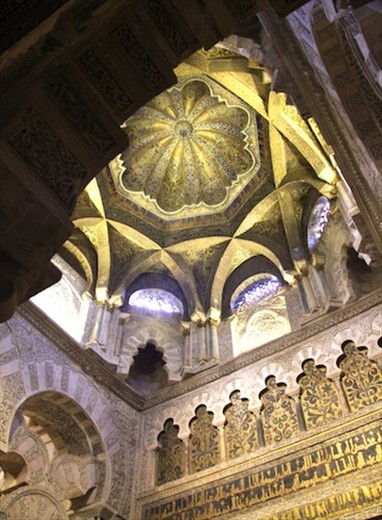Cordoba, once Roman and later Visigoth, came into its own in the 8th Century when the Umayyad Muslims made it the capital of Al-Andalus, Islamic Spain. While the rest of Europe succumbed to the ignorance and superstition of the Dark Ages, Al-Andalus was a center of knowledge and science. Cordoba’s paved streets were filled with Jews, Christians and Muslims, all getting along. Islam reigned supreme, however. No church steeple could be higher than the minaret of a mosque. And the Mezquita was the greatest of all the mosques.

Dome above the Mithrab, Islamic altar
Today the Mezquita is the most popular site in Cordoba. To my mind it is the equal of the Blue Mosque and Hajia Sofia in Istanbul in its design, symmetry and complexity. The mosaics and arches above the mithrab take your breath away. It must have been a sight to behold during the Golden Age of Cordoba when the orange trees in the courtyard morphed into the 850 marble and alabaster pillars of the interior, salvaged from Roman and Visigoth temples and churches. When sunlight streamed through the arches (now sealed in) to illuminate the red and white double arches that are both artistic and structural.

850 columns support red and white double arches
All good things must end. As today there was division in the Muslim world. With the fall of the Umayyads in 1031, power shifted to Granada and Sevilla. When the Christians finally retook Cordoba in 1236 the Mezquita became a cathedral almost overnight. Today a cathedral rises in the center of the Mezquita, dominating the skyline. Oh-so-Catholic Spain makes a point of highlighting Visigoth mosaics beneath the floor of the one-time mosque, “proving” that the Mezquita is – and should rightfully be – a church.

Visigoth mosaic from 4th Century
The narrow streets of the Jewish quarter are a delight to wander, especially in May when the “patios” are in full-bloom. The residents take great pride in decorating their homes and the interior courtyards in bright flowers and competing for the best patio. This is in contrast to the more modern art deco area where the real work of Cordoba takes place. Everything slows down in the afternoon, the perfect time to try a “menu del dia,” three courses for ten euros including wine or beer. Rather than wait until 8 or 9 PM for dinner we’ve taken to eating our big meal in the afternoon and having fruit and cheese and crackers in the evening. Gotta go with the flow.